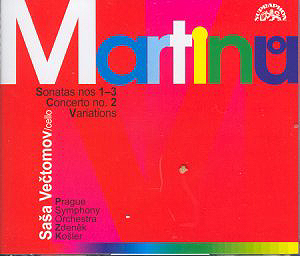These
recordings were made during the first blooming of the Martinů
revival. The composer, effectively an exile from his homeland,
had died only seven years before the first of these recordings
were made. The seventy-fifth anniversary of his birth passed in
1965. With agonising slowness the then Czechoslovakia began to
produce the Supraphon LPs that acted as emissaries for his music
across the world. In the 1970s these LPs were still in evidence
in record shops and in the UK at the bigger retail chains like
W.H. Smiths who often purchased them in bulk and included them
in their racks during the January and summer sales. Picking up
these Supraphons at between 75p and Ł1.25 broadened not a few
horizons. Of course their poorly translated notes provided easy
scavenging for the critics but their repertoire coverage and the
often vivid quality of the performances won many new friends among
young and impecunious collectors.
Alexandr
or Saša Večtomov (1930-1989) had distinguished musical forebears.
His father, Ivan, was leader of the Czech Phil. He studied at
the Prague Conservatory with Ladislav Zelenka and completed his
studies with Kozolupov in Moscow. He won many prizes (1955 Spring
Prague; 1959 Casals in Mexico) and toured worldwide with the Czech
Trio. He taught at Prague's Academy of Music.
Josef
Páleníček (1914-1991) has recorded the third and fourth of
Martinů's piano concertos. He was taught in Prague and Paris.
In 1934 he founded the Smetana Trio later dubbed the Czech Trio
joined from 1956 by Saša Večtomov. Between 1949 and 1962
he was often soloist at concerts of the Czech Phil.
The
two artists deliver warm and internalised readings of the three
sonatas. Večtomov's tone is chesty, richly endowed, nasal
and 'sticky' when high in the register. The approach is to accentuate
the melodic so there is a more rounded, undulant contour than
in the very slightly angular readings of Jírí Hanousek and Paul
Kaspar and the spare recording tone on Centaur CRC 2207. These
three sonatas coupled on CD1 are products of Martinů's high
maturity. Večtomov and Páleníček make a grand tragic
statement of the Largo of the Second Sonata displaying
an impressive grip on structure. The singing lines of the Fourth
Symphony reach out from their allegro comodo (tr. 6). The
recording in the Domovina Studio conspires to emphasise the burgeoning
warmth of this music especially noticeable in the last two sonatas.
The First Sonata is by no means the neo-classical frivolity
one might expect from its partly Parisian provenance. It is closer
to the Concerto for Double String Orchestra, piano and timpani.
The Rossini Variations are on a theme from Mose
in Egitto. It was written for Gregor Piatigorsky to a commission.
It is bright, pompous, humorous, hiccuping and ultimately Paganinian
in its showy and storm-tossed leger-de-main. It has its stilly
night as well in the Pierrot moonscape (6.41). The Slovak
Variations were written just six months at the home of
Paul Sacher (who premiered both Gilgamesh and The Greek
Passion) before the composer’s death. This time the theme
(Kebych já vedela, kde môj milý kosí)
is allowed to bloom towards a nostalgic sun. This is one of Martinů's
most concentratedly lyrical pieces. You may have in mind the folk
based piano solos but here he goes further - this is the pastoral
landscape intensified, the composer with head-bowed - reverential.
In the last three minutes rhythmic life floods back with stamping
rhythms and swinging melodic material which occasional reminds
the listener of Szymanowski's Harnasie music.
Večtomov's
Supraphon LP recording of the Cello Concerto No. 2 gained
the Grand Prix Paris' Academie Charles Cros in 1970. Večtomov
premiered the concerto in České Budějovice in May 1965
with the same conductor and orchestra who recorded the work just
over a year later. Martinů wrote the work during his long
American exile between Christmas 1944 and February 1945. His aching
homesickness can at this vantage point be seen as an emotional
counterpart to Rachmaninov's amour lointain for Russia.
Martinů's Czechoslovakia and Rachmaninov's Russia were remote
and unattainable and not just because of geography. The Second
Concerto was the last of his works for cello and orchestra. It
is infused with the natural singing soul of the cello - an accent
apt to Večtomov's innate sympathies. In none of the alternative
recordings does the dancing songfulness of the piece communicate
so well. The cello is recorded closely and makes a lovely sound
though, as with all the 1960s recordings here, without high-end
brilliance or much transparency. In its place there is a surging
fullness of sound - listen to the horn-topped density at 6.40
in the first movement. Ultimately this work suffers a debilitatingly
glorious dose of languor and nostalgia. It is no doubt exactly
what Martinů wanted to say but across almost 40 minutes it
may be just too much of a good thing. If you want only the cello
concertos then Wallfisch on Chandos is your best bet. Otherwise
these warm recordings of most of the cello works is well worth
getting. Večtomov's songful Slovak Variations, the intense
first movement of the Second Concerto and largo of the Second
Sonata are the outstanding highlights of this retrospective.
This
is not the complete cello output. Missing are the Concertino (1924),
Concerto No. 1 (1930, 2nd version 1939, final 1955) and the Sonata
da Camera.
This
set with its slightly congested opaque sound is a treat for Martinů
lovers who want to hear how the two champions of his music developed
a performing style.
Rob
Barnett
